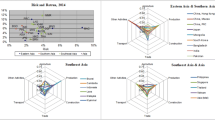Abstract
In the ordinary macro-economic input–output tables, the industrial sector consists of several dozen industries and each industry in a certain sector is an aggregate of many companies in the sector. The sectoral statistics are the sum of statistics of companies in the respective sector. Usually, all sectors have the same set of inputs for producing outputs. For example, they have labour, capital and intermediate input as input and amount of production as output. We can apply traditional DEA models for evaluation of efficiency regarding all sectors by means of these common input and output factors. However, there remain concerns about comparing all sectors as a scratch race. Some sectors are in fields with matured technologies, while others are in emerging fields. Some are labour intensive, while others are capital intensive. These situations lead us to compare sectors under a handicap race. In this paper, we propose a new DEA model based on the non-convex frontiers that all associated sectors may exhibit and from which handicaps are derived. We apply this model to Ethiopian industry.





Similar content being viewed by others
Notes
See Tone and Sahoo (2006) for scale elasticity measurement in cost efficiency.
The 2008 data is part of the big dataset (covering 2000–2009) we had. We first made a 4-year moving average adjustment using the 2000–2009 dataset and then extracted the 2008 data for the purpose of this application.
References
Avkiran, N. K., Tone, K., & Tsutsui, M. (2008). Bridging radial and non-radial measures of efficiency in DEA. Annals of Operations Research, 164(1), 127–138.
Banker, R. D., & Morey, R. C. (1986). Efficiency analysis for exogenously fixed inputs and outputs. Operations Research, 34(4), 513–521.
Dinh, H., Palmade, V., Chandra, V., & Cossar, F. (2012). Light manufacturing in Africa: Light manufacturing private investment and create job. Washington: World Bank.
Fixler, D. J., & Zieschang, K. D. (1993). An index number approach to measuring bank efficiency: An application to mergers. Journal of Banking and Finance, 17, 99437–99450.
Lazano, S., & Villa, G. (2010). Gradual technical and scale efficiency improvement in DEA. Annals of Operations Research, 173(1), 123–136.
Olsen, O. B., & Petersen, N. C. (2009). Target and technical efficiency in DEA: Controlling for environmental characteristics. Journal of Productivity Analysis, 32, 27–40.
Sonobe, T., Akoten, J., & Otsuka, K. (2009). An exploration into the successful development of the leather-shoe industry in Ethiopia. Review of Development Economics, 13(4), 719–736.
Tone, K. (2001). A slacks-based measure of efficiency in data envelopment analysis. European Journal of Operational Research, 130, 498–509.
Tone, K., & Sahoo, B. K. (2006). Re-examining scale elasticity in DEA. Annals of Operations Research, 145(1), 69–87.
Tone, K., & Tsutsui, M. (2015). How to deal with with non-convex frontiers in data envelopment analysis. Journal of Optimization Theory and Applications, 166(3), 1002–1028.
Yang, Z. & Paradi, J. C. (2006). Cross firm bank branch benchmarking using “Handicapped” data envelopment analysis to adjust for corporate strategic effects. In Proceedings of the 39th Hawaii international conference on system sciences, pp. 1–10.
Author information
Authors and Affiliations
Corresponding author
Appendix
Appendix
We summarise the steps for the SAS computation as follows:
-
Step 1 Input data (X, Y, Cluster). Cluster can be supplied exogenously by some clustering methods, including experts’ knowledge, or determined internally depending on the degree of scale-efficiency;
-
Step 2 For \(k=1,\ldots ,n,\) solve the CRS and VRS models to obtain the CRS and VRS scores, \(\theta _k^{CRS} \) and \(\theta _k^{VRS} \), respectively. Define the scale-efficiency \(\sigma _k :={\theta _k^{CRS} }/{\theta _k^{VRS} }\);
-
Step 3 Using the optimal slacks \((\mathbf{s}_k^{-*} ,\mathbf{s}_k^{+*} )\) for the CRS model, define the scale-dependent slacks as \(((1-\sigma _k )\mathbf{s}_k^{-*} ,(1-\sigma _k )\mathbf{s}_k^{+*} );\)
-
Step 4 Define the scale-independent data set \((\overline{\mathbf{X}} ,\overline{\mathbf{Y}} ):=\left\{ {({\bar{\mathbf{x}}}_k , {\bar{\mathbf{y}}}_k )\left| {k=1,\ldots ,n} \right. } \right\} \) by:
$$\begin{aligned}&\hbox {Scale-independent input }{ \bar{\mathbf{x}}}_k :=\mathbf{x}_k -(1-\sigma _k )\mathbf{s}_k^{-*} ,\;\hbox {Scale-independent output }\\&{ \bar{\mathbf{y}}}_k :=\mathbf{y}_k +(1-\sigma _k )\mathbf{s}_k^{+*} ; \end{aligned}$$ -
Step 5 Solve the CRS model (15) for each \(({ \bar{\mathbf{x}}}_k ,{ \bar{\mathbf{y}}}_k )\)referring to the \((\overline{\mathbf{X}} ,\overline{\mathbf{Y}} )\) in the same cluster (k), and obtain the optimal in-cluster slacks \((\mathbf{s}_k^{cl-*} ,\mathbf{s}_k^{cl+*} )\);
-
Step 6 Define the SAS by:
$$\begin{aligned} \theta _k^{SAS} :=1-\frac{1}{m}\mathop {\sum }\limits _{i=1}^m {\frac{s_{ik}^{cl-*} +(1-\sigma _k )s_{ik}^{-*} }{x_{ik} }} ; \end{aligned}$$ -
Step 7 Obtain the scale and cluster adjusted input and output (projection) \(({ \bar{{\bar{\mathbf{x}}}}}_k ,{ \bar{{\bar{\mathbf{y}}}}}_k )\)by:
$$\begin{aligned} { \bar{{\bar{\mathbf{x}}}}}_k :=\mathbf{x}_k -(1-\sigma _k )\mathbf{s}_k^{-*} -\mathbf{s}_k^{cl-*} \hbox {,}\; {\bar{{\bar{\mathbf{y}}}}}_k :=\mathbf{y}_k +(1-\sigma _k )\mathbf{s}_k^{+*} +\mathbf{s}_k^{cl+*} ; \end{aligned}$$ -
Step 8 We define the scale and cluster adjusted dataset by \(({\mathop {\mathbf{X}}\limits ^{=}}, {\mathop {\mathbf{Y}}\limits ^{=}} ):=\left\{ {({\bar{\bar{\mathbf{x}}}}_j ,{\bar{\bar{\mathbf{y}}}}_j )\left| {j=1,\ldots ,n} \right. } \right\} .\)
Rights and permissions
About this article
Cite this article
Hailu, K.B., Tone, K. Setting handicaps to industrial sectors in DEA illustrated by Ethiopian industry. Ann Oper Res 248, 189–207 (2017). https://doi.org/10.1007/s10479-016-2225-1
Published:
Issue Date:
DOI: https://doi.org/10.1007/s10479-016-2225-1




